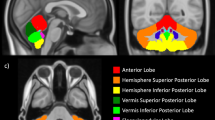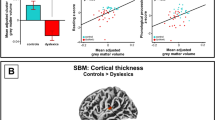Abstract
Sultan's observations do not contradict our finding that, when normalized to the whole brain, cerebellar volume is relatively constant. To make interspecies comparisons, we used the volume fraction (the volume of a component divided by the total brain volume)1. Without this normalization, the dominant trend is variation in absolute size2. This logic applies to surface areas as well, and Sultan's interesting analysis reflects this principle.
This is a preview of subscription content, access via your institution
Access options
Subscribe to this journal
Receive 51 print issues and online access
$199.00 per year
only $3.90 per issue
Buy this article
- Purchase on SpringerLink
- Instant access to full article PDF
Prices may be subject to local taxes which are calculated during checkout
Similar content being viewed by others
References
Jerison, H. J. Brain Size and the Evolution of Mind (Am. Mus. Natl Hist., 1991).
Finlay, B., Darlington, R. & Nicastro, N. Behav. Brain Sci. 24, 263–278 (2001).
Frahm, H. D., Stephan, H. & Stephan, M. J. Hirnforsch. 23, 375–389 (1982).
Hofman, M. A. Brain Behav. Evol. 32, 17–26 (1988).
Gould, S. J. in Approaches to Primate Paleobiology (ed. Szalay, F. S.) 244–292 (Karger, Basel, 1975).
Stanhope, M. J. et al. Proc. Natl Acad. Sci. USA 95, 9967–9972 (1998).
Mouchaty, S. K., Gullberg, A., Janke, A. & Arnason, U. Mol. Biol. Evol. 17, 60–67 (2000).
Zhang, K. & Sejnowski, T. J. Proc. Natl Acad. Sci. USA 97, 5621–5626 (2000).
Author information
Authors and Affiliations
Corresponding author
Rights and permissions
About this article
Cite this article
Wang, SH., Mitra, P. & Clark, D. How did brains evolve?. Nature 415, 135 (2002). https://doi.org/10.1038/415135a
Issue date:
DOI: https://doi.org/10.1038/415135a



